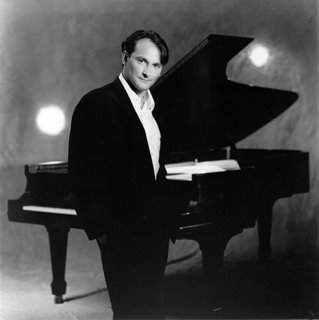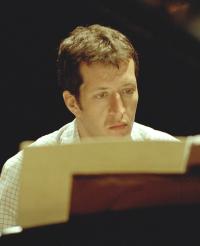Also on Ionarts:
Ionarts in Santa Fe: The Tempest Revisited (August 3, 2006)
More on "The Tempest" (July 30, 2006)
The Tempest (July 29, 2006)
Preview: Santa Fe Opera, Summer 2006 (July 19, 2006)
Other Reviews:
Craig Smith, Ades brings telling sea change to 'Tempest' (Santa Fe New Mexican, July 31) [The cranky comments on this article are not to be believed.--Ed.]
J. A. Van Sant, Strong Tempest at Santa Fe (Opera Today, July 31)
Scott Cantrell, New take on 'The Tempest' (Dallas Morning News, August 4)
James R. Oestreich, Santa Fe Opera Offers Love on a Stormy Island (New York Times, August 5)
Joshua Kosman, Thomas Adès' American premiere of 'Tempest' opera is a magical marvel of sound (San Francisco Chronicle, August 5) |
The plays of Shakespeare may seem like the perfect sort of dramatic work for operatic adaptation, with memorable characters, moments of grand expression, and marvelous scope of setting. There are basically two models for past success: Verdi's late masterpieces, which are distant from their sources because the libretti are in Italian; and Britten's
A Midsummer Night's Dream, the best example of a Shakespeare opera in English, which uses the original text almost verbatim. The main drawback in
The Tempest, the 2004 opera by British composer Thomas Adès, is that it is in English, but the retelling of the story in simpler language reads and sounds sadly like Shakespeare's homespun cousin. After a few days before the first performance of the opera, now in its American premiere at
Santa Fe Opera, spent reading and studying Shakespeare's play again, the lightly rhymed, short-lined libretto by Meredith Oakes was a disappointment.
Shakespeare's play is a confusing aesthetic experience. It is a complicated story that does not necessarily leave you with any clear message. By removing its subtleties, the libretto also bleaches out most of the interest. You will not recognize Shakespeare's characters in the operatic version. Prospero is no longer the omnipotent thaumaturge: in Shakespeare, he directs Ariel to bring Ferdinand and his daughter, Miranda, together and is happy to see love blossom between them, having already announced his plan to see his child married to the son of his mortal enemy. In the opera, Prospero is helpless to stop the two young people from falling in love, and it seems to be against his plans.
Ariel is not explicitly a male spirit, but the possessive pronoun applied by Shakespeare is "his" instead of "her," while Adès and Oakes cast Ariel as one of the most striking coloratura roles ever conceived for the stage. The host of other spirits in the masque scenes of Shakespeare's plays almost disappear in the opera, to be replaced by a chorus identified as "The Court," a host of well-heeled people who land on the island with Antonio, Sebastian, and Gonzalo. The opera enhances the roles of Prospero's enemies, while diminishing the characters at the center of the play. Nothing happens in Shakespeare's play without being part of Prospero's ultimate plan, while in the opera the action seems to overwhelm Prospero, leaving Ariel and Caliban the apparent victors, in possession of the island.

The Tempest, Santa Fe Opera, set and costumes designed by Paul Brown,
photo by Ken Howard © 2006 |
Nevertheless, while I think that there are better ways to adapt
The Tempest as an opera, Adès has composed something that deserves to be remembered, recorded, and performed widely. The score is paced very well, never dragging and always creating interest for the listener. Each act is more or less one continuous scene, although there are a few sections we might call arias and ensemble pieces that are set off by changes in style. At the
symposium I attended on the morning of the premiere, the moderator asked Adès if he was most attracted by or sympathized with any one particular musical style or –ism; he paused for a well-timed moment, leaning toward the microphone, and said very dryly and to much laughter, "No."
The Tempest veers between thorny dissonance (in the opening storm scene) and lush consonance (Ariel's agonizingly beautiful aria "Five fathoms down"), between contrapuntal complexity (the Act III sextet) and diaphanous orchestration (the clanging, sonorous masque scene). One could suggest similarities with the work of other composers, but this young composer (b. 1971) has found a unique voice, making such comparisons beside the point.
Director Jonathan Kent and set/costume designer Paul Brown wanted to flood the orchestra pit, a plan that was, wisely, not approved. They did incorporate a small pool of water at the front of the stage. In the dissonant eponymous storm that begins the opera, the chorus members of the Court rise up from an opening and pass through the pool, walking like zombies out of the water and across the yellow sand of the island. The basic set does not change through the opera's three acts, a raked island covered with yellow material that shines brightly under the lights. Several trap doors allow characters to sink into the island, as if in quicksand, or rise out of it, as Ariel does on a ladder. A large, leafless tree grows from the upstage corner, where Ariel and Prospero often hover over the proceedings. The costumes play with the juxtaposition of the desert island fantasy world with modern reality. The members of the Court look more or less like the British royal family and retinue. Ariel, spirit of the air, is a blue-plumed bird, and Caliban's "costume" consists mostly of a few splashes of mud.

Toby Spence as Ferdinand and Patricia Risley as Miranda, The Tempest, Santa Fe Opera, set and costumes designed by Paul Brown, photo by Ken Howard © 2006 |
Certainly, the triumph of this opera is the role of Ariel, an insanely strenuous use of the coloratura, truly birdlike, and not only in limited sections but with terrifying consistency. Toby Spence confided that many of the singers who created the opera were not sure that what Adès intended was even possible. The remarkable soprano Cyndia Sieden, reprising the role in Santa Fe after a triumphant premiere in London, arrived at a most satisfying approach, which involves a lightness that captures Ariel's inhuman quality. Quite rightly, she received the loudest ovation at the curtain call, and I found myself longing for her next entrance and shaking my head in admiration when she finished yet another incredible performance. Here she was directed to emphasize the avian nature of the role, made clear by her bright, lovely costume.

Cyndia Sieden as Ariel, The Tempest, Santa Fe Opera, costume designed by Paul Brown, photo by Ken Howard © 2006 |
No one in the cast was anything less than good. Special mention must be made of William Ferguson, who had the unfortunate task of stepping into Ian Bostridge's shoes in the role of Caliban. He excelled as the pathetic, earthly monster that Adès and Oakes made of Caliban, evoking an otherworldly delight in the final scene of the opera, as Ariel echoed from the wings his plaintive calls over the empty island. Toby Spence and Patricia Risley were a handsome couple as Ferdinand and Miranda, both physically and vocally, the unity of the pair represented in the closeness of their ranges. Bass Wilbur Pauley (Stefano) and countertenor David Hansen (Trinculo) made a charming Mutt and Jeff, distanced as they were in range, as the pair of clowns. The valiant Rod Gilfry seemed to struggle the most as Prospero, both with the numerous high-range demands of the role as well as the strain of being on stage and singing for so much of the opera. Santa Fe Opera music director Alan Gilbert conducted the fine orchestral ensemble, which after a slightly rocky start in the tempest scene (with percussion and other parts not quite lining up rhythmically), played very well. The strength of Thomas Adès, in my opinion, is his magical use of the orchestra to evoke countless colors and timbres, with a special favoring of glassy string chords, tinkly percussion, and the rumbling bluster of low instruments like the contrabassoon and low brass, which now and then poke their massive, mossy heads out of the orchestra.
The Santa Fe Opera has scheduled only three more performances of
The Tempest, on August 2, 11, and 17. I will hear the first of those, but if I were in New Mexico through the end of August, I would be happy to hear all of them.











































































